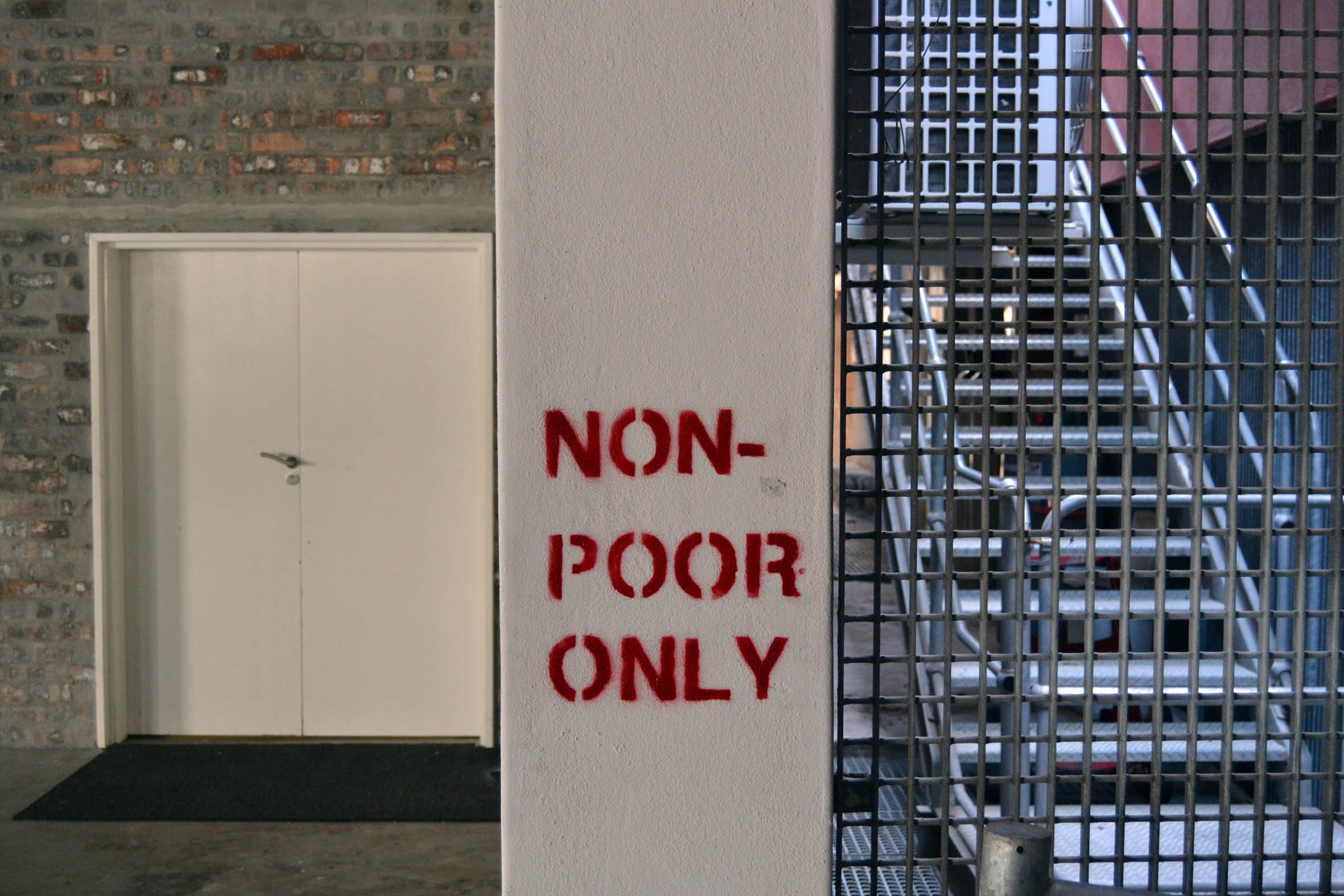Guerilla art group Tokolos Stencil Collective poses dirty challenges to audiences and the art gallery.
Defacing the Mandela Ray-Ban sculpture is not all that the Tokolos Stencil Collective, who most Capetonians know for the ubiquitous “Remember Marikana” stencils throughout the city, has been up to lately. A soiled government-issue porta-potty filled the Brundyn+ gallery in Cape Town with the stench of human faeces on the opening night of the Plakkers group exhibition of street art.
This intervention by the Tokolos Stencil Collective was unsanctioned by the gallery, as were the “dehumanisation zone” stencils and scrawled “bourgeoisie gallery” slogan spray-painted on the building façade in the dead of the previous night.
“The intention of our ‘Non-poor Only’ stencil sprayed directly on to the ‘porta-porta’ was a critique of the highly problematic nature of the Brundyn+ gallery and bourgeois spaces like it across South Africa,” reads the anonymous collective’s statement, which described the gallery’s immediate removal of the toilet as censoring “the smell of decades of indignity and oppression meted out against Cape Town’s poor”.
The intervention was simultaneously replicated during the Open City event held in the public space of Church Square during the First Thursdays festivities. “We feel that the entire #FirstThursdays initiative is an exclusionary space meant to help the middle class pretend that their culture is significant and relevant,” reads their website, tokolos-stencils.tumblr.com.
“Instead, First Thursdays merely serves to exclude the poor black underclass. Many of the art installations talk about the poor but rarely, if ever, do they actually build space of inclusion.” Of course, this is hardly the first toilet in contemporary art. Marcel Duchamp’s Fountain – a urinal signed simply “R Mutt 1917” – was voted the most influential art work of all time by more than 500 art experts in the run-up to the 2004 Turner Prize in Britain.

“Poor only”
The work raises a number of questions, most basically: What is art? Is it whatever the artist says it is? A number of artists, including South Africa’s Kendell Geers, have pulled out all the stops to answer this question by urinating in Duchamp’s gallery-reified urinals. Artist, musician and original producer of U2 Brian Eno stored his urine in a test tube that was poured through a crack in the sculpture’s protective Perspex case.
In a less egotistical response, British pop artist Alex Garnett commodified the question with his “Conceptual Crap” sticker that sports a “R Mutt 1917” signature. It can be bought at most gallery shops in Europe for (relatively humble) £6.50 and encourages everyone to turn their lavatory into a replica of the work.
It is, however, unclear whether the anonymous collective considers their porta-potty art, as the statement reads: “Tokolos made no claim to professional artistic intervention. We are not engaging in this conversation as artists but as an anonymous and universalised image of the worker wearing gas masks and blue overalls, and carrying our luggage of shit to disrupt spaces in which poor blacks are not welcome.”
Unlike Garnett’s commodification, Tokolos’s “poor only” slogan is available as a stencil for free download with instructions from its website. Everyone is encouraged to get involved, anyone can be a tokolos. When I contacted Tokolos for comment, I was informed that I had to be complicit in the collective – spray a stencil somewhere or another agreed-on action that I could think of – before it would co-operate.
‘The motives also come under scrutiny’
This raises the question of who the Tokolos Stencil Collective is. According to an interview with Dave Mann in Archetype Online magazine, the collective itself is not entirely sure: “We are a loose collective. We don’t really have members, just participants.” If not even the participants know who is in the group, how does one control what the group stands for, or prevent enemies sabotaging its directive? The motives also come under scrutiny.
If it is not money or artistic acclaim, then it is presumably to raise awareness. Yet nowhere in the media generated has Tokolos highlighted the organisations rallying against the poor sanitation infrastructure in Cape Town. Just over a month ago, the Social Justice Coalition released its toilet audit to a defensive City of Cape Town. And the night before Tokolos’s intervention, controversial leader of the “poo protesters”, Ses’khona People’s Rights Movement, Andile Lili, was shot outside his house.
Without this element of social pragmatism, Tokolos limit their effectiveness to the art realm. However, unlike Duchamp or Michael Elion – artist of the Mandela Ray-Ban sculpture – who declare art is in the eye of the artist, Tokolos stipulates in its statement that “real art makes those with privilege feel uncomfortable”.